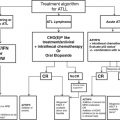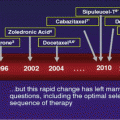Molecule
Indication
ARV
Cytochrome
Effect
Action
All
PI
3A4/5
Specialist advise
Cyclophosphamide
Breast
NNRTIs
2B6, 2C9, 3A4
Increase toxicity and efficacy
Monitoring
Docetaxel
Breast, prostate
NNRTIs
3A4
Increasing toxicity
To avoid – change taxane
Erlotinib/gefitinib
Lung
NNRTIs
3A4
Toxicity
Avoid/monitoring
Etoposide
Lung, neuroendocrine
NNRTIs
3A4, UGT1A1
Toxicity
Monitoring
Everolimus
Renal, breast
NNRTIs
3A4
Toxicity
Avoid
Ifosfamide
Sarcoma
NNRTIs
3A4, 2B6
Decreasing efficacy
–
Imatinib
LMC, GIST
NNRTIs
3A4, 1A2, 2D6, 2C9, and 2C19
Toxicity
Monitoring
Irinotecan
Colorectal
NNRTIs
3A4
Toxicity
Monitoring
Lapatinib
Breast
NNRTIs
3A4
Toxicity
Monitoring
Methotrexate
Leukemia
NNRTIs
NRTIs
Contraindicated/monitoring
Paclitaxel
Breast, ovarian, lung, cervical, Kaposi sarcoma
NNRTIs
2C8, 3A4
Toxicity
Monitoring
Tamoxifen
Breast
NNRTIs
2D6, 3A4
Decreasing efficacy
Monitoring
Vinblastine
Lymphoma
NNRTIs
3A4
Toxicity
Monitoring
Capecitabine/5Fluorouracil
Breast, colorectal
NRTIs
Toxicity
Monitoring
Platine
Lymphoma, lung, cervical, ovarian
NRTIs
Neurotoxicity
Monitoring
In addition, these drug interactions also concern supportive care treatment and the use of analgesics, antiemetics, and corticoids that are possibly needed in cancer treatments.
Third, opportunist infections, such as pneumocystosis and toxoplasmosis, and their preventive treatments should be considered.
Finally, treatment compliance and follow-up should be adapted to each patient, so multidisciplinary staff such as CANCER VIH group in France, consultation, and supportive care are essential [24].
3 HIV and Cancer Treatments in Low- and Middle-Income Countries
3.1 Epidemiology
Based on the WHO data, 24.7 million people live with HIV in sub-Saharan Africa (SSA) in 2013. 70 % of new HIV infection in the world is in SSA.
In 2013, more than 12.9 million people with HIV are treated by a HAART worldwide of which 11.7 million in LMICs.
We can obviously consider HIV like a worldwide public health problem. So by referring causes of death in PLHIV in high-income countries, cancer in LMICs must be considered as a priority in HIV patients care.
3.2 HIV and Cancer
Many data concern epidemiology of HIV-associated cancers from high-income countries. Our knowledge of the epidemiology of HIV-associated cancers in LMICs is limited. The reasons include weaknesses in healthcare infrastructure for diagnosing malignancies and limited epidemiological expertise in these countries. Moreover, many cancers are probably undiagnosed or untreated, so comprehensive information from cancer registries cannot be obtained [6].
Thus, we rely on high-income countries epidemiological profile and evolution in HIV-associated malignancies to assume evolution in low-middle income countries.
3.3 Treatment in HIV-Associated Cancer
Treatment of PLHIV must be optimal in controlling HIV with a low viral replication and a higher number of CD4 cells, such as recommended in the WHO guidelines [9].
Cancer treatment will depend on tumor type and international recommendation guidelines such as described in the previous chapters.
Problems of drug interactions are the same as in high-income countries, and a special care is needed. The challenge will be in accessibility in specific treatments and their costs.
Because of a higher incidence of associated infections, it is important to test and treat them, particularly for HBV and tuberculosis, and to prevent the strongyloïdes hyperinfection with ivermectin under corticosteroid therapy, commonly used in cancer treatments.
Hence, developing prevention, early diagnoses, and cancer infrastructure might be a key to develop a better patient care. Unfortunately, cancer infrastructures are underdeveloped particularly in SSA [28]. Adebamowo et al. study suggests that the infrastructure for cancer should comprise four elements: physical infrastructure, qualified staff, supportive policies, and supportive laws [6]. Established HIV care infrastructure in SSA would be a base to support the training of cancer care professionals, but efforts are needed to increase the human capacity for patients care with HIV-associated malignancies. Partnerships between international and US institutions have already begun and must be continued to address this need [29].
Stay updated, free articles. Join our Telegram channel

Full access? Get Clinical Tree





